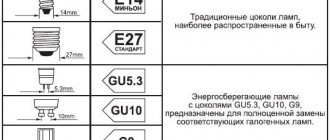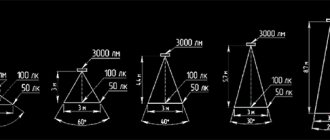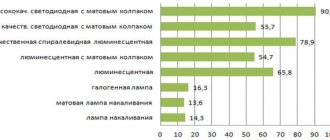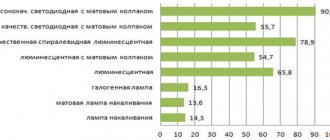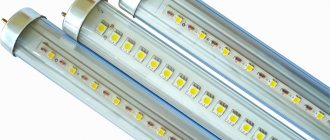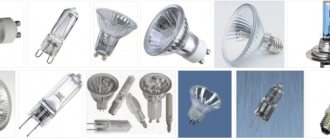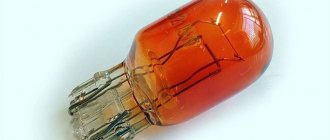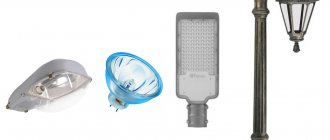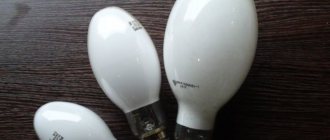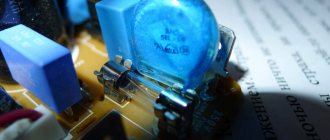General structure and principle of operation of SMD LEDs
This type of LED is a board on the surface of which a crystal grown using metal-organic epitaxy technology is fixed. The most important stage of production is the creation of contacts and their coating with metal films.
Each diode is mounted in a housing, equipped with leads, and coated with a compound that removes or emits light. White LEDs are coated with phosphor. A dome is installed on the crystal to focus the light. Heat is removed through the substrate; if the diode is powerful, a radiator is installed. Electrical current is converted into light in a pn junction (just like any other diode).
The main advantage of the SMD design is the maximum proximity of the crystal to the substrate, which removes heat. One or more LEDs are mounted on one board. If there are a large number of them in one lighting device, the light is powerful enough without installing additional optical systems. Ordinary glass is sufficient, the losses due to which do not exceed 8%.
SMD packages vary in shape and size and are directly connected to the circuit board using a pad.
Attention! Due to its simplicity, installation can be performed by a non-specialist.
Diode marking
Marking of output diodes:
The most common coding systems are:
JEDEC (USA) - Standardized EIA370 N-series numbering system.
Code type: .
The first digit is a number reflecting the number of transitions in the element (1 for diodes).
The letter is always the letter “N”.
Serial number is a two-, three-, or four-digit number that reflects the EIA registration number of the semiconductor device.
Suffix - reflects the breakdown of devices of the same type into different standard ratings according to characteristic parameters. A suffix can consist of one or more letters.
For example: 1N34A/1N270 (germanium diode), 1N914/1N4148 (silicon diode), 1N4001-1N4007 (1A silicon rectifier diode) and 1N54xx (3A power silicon rectifier diode).
PRO ELECTRON (Europe);
The designation consists of four elements.
The first element is a letter indicating the type of semiconductor material used in the device:
- A – germanium;
- B – silicon;
- C – gallium arsenide;
- R – other semiconductor materials.
The second element is a letter indicating the type of semiconductor device:
- A – low-power pulsed and universal diodes;
- B – varicaps;
- E – tunnel diodes;
- G – special-purpose devices (for example, generators), as well as complex devices containing several different components in one housing;
- H – magnetically sensitive diodes;
- P – photosensitive devices (photodiodes, phototransistors, etc.);
- Q – light-emitting devices (LEDs, IR diodes, etc.);
- X – multiplying diodes;
- Y – rectifier diodes, boosters;
The third element is a letter, which is placed only for devices intended for use in special-purpose equipment (industrial, professional, military, etc.). Typically the letters “Z”, “Y”, “X” or “W” are used. This element is absent in the designations of general-purpose devices.
The fourth element is the two-, three- or four-digit serial number of the device.
The designation may also contain some additional elements. For example, the suffix is the same as in the JEDEC system, which reflects the breakdown of devices of the same type into different standard ratings according to characteristic parameters.
For some types of devices (such as zener diodes), additional classification may apply. In this case, an additional code is added to the main designation (may also be separated by a hyphen or fraction). For example, an additional code is often used containing information about the stabilization voltage and its possible spread (“A” – 1%, “B” – 2%, “C” – 5%, “D” – 10%, “E” – 15 %). If the stabilization voltage is not an integer, then the letter V is placed instead of a comma. The additional code for rectifier diodes indicates the maximum amplitude of the reverse voltage.
For example, BZY88C4V7 is a special-purpose silicon zener diode with registration number 88, a stabilization voltage of 4.7 V with a maximum deviation of this voltage from the nominal value of ±5%.
Table 1 - Color coding of diodes (PRO ELECTRON).
JIS (Japan, Asia);
The designation consists of five elements.
The first element is a number reflecting the number of transitions in the element (0 – photodiodes; 1 – diodes).
The second element is the letter “S”, which stands for semiconductors.
The third element is a letter indicating the type of semiconductor device:
- E – diodes;
- G – Gunn diodes;
- Q – light emitting diodes;
- R – rectifier diodes;
- S – low-current diodes;
- T – avalanche diodes;
- V – varicaps, pin diodes, charge storage diodes;
- Z – zener diodes, limiters.
The fourth element is the serial (registration) number of the device.
The fifth element is a modification of the device (“A” is the first, “B” is the second, etc.).
The standard marking may be followed by an additional index (“N”, “M”, “S”), reflecting some special properties of the device.
Marking of SMD diodes:
SMD diodes are usually marked using an alphanumeric code. Depending on the type of case (i.e. its size) and manufacturer, one or another coding system is used. It is quite obvious that it is not possible to consider all types of coding. Therefore, below we will consider some codes for the most commonly used diode packages. You can see a more complete version of SMD diode coding systems.
For SOD80 (MiniMELF) housings:
Example:
BZV87-1V4 – silicon zener diode for stabilization voltage 1.4 V.
The remaining values of the zener diodes are coded in a similar way.
Color coding:
Often the manufacturer codes only the type of diode:
For SOT89 housings:
Brief technical specifications
When manufacturing lighting fixtures, manufacturers are guided by several characteristics:
- board dimensions;
- number of crystals;
- voltage and current;
- light flux;
- temperature of the operating environment.
Table of the most common SMD LEDs:
| SMD type | Number of crystals | Dimensions (mm) | Power, W) | Current (mA) | Luminous flux (lm) | Ambient temperature |
| 3528 | 1 | 3.5x2.8x1.4 | 0.02 or 0.06 | 20 | 5-7 | -40 – +85 |
| 5050 | 3 or 4 | 5x5x1.6 | 0,02 | 60 or 80 | 18-20 | -40 – +60 |
| 5630 | 1 | 5.6x3x0.75 | 0,2-0,4 | 150 | 58 | -25 – +65 |
| 5730 | 1 or 2 | 5.7x3x0.75 | 0.5 or 1 | 150 or 300 | 50 or 158 | -40 – +65 |
| 3014 | 1 | 3x1.4x0.75 | 0,1-0,12 | 30 | 9-13 | -40 – +85 |
| 2835 | 1 | 2.8x3.5x0.8 | 0.2, 0.5 or 1 | 60, 150 or 300 | 20, 50 or 100 | -40 – +85 |
These bulbs can be single, double or multi-colored. From them you can create rigid and flexible modules of any shape (round, rectangular, linear, with a base). A round radiator is used in floodlights.
Reference! The number of diodes in the module is gradually decreasing due to the advent of high-voltage SMDs (15 and even 45 V).
Color coding of diodes in SOD-80 packages
The SOD-80 body, also known as MELF, is a small glass cylinder with metal leads.
Examples of diode markings.
Marking 2Y4 to 75Y (E24 series) BZV49 1W silicon zener diode (2.4 – 75V) Marking C2V4 to C75 (E24 series) BZV55 500mW silicon zener diode (2.4 – 75V)
The cathode terminal is marked with a colored ring.
Marking of devices with colored rings.
| Cathode output | Device |
| Black | BAS32, BAS45, BAV105 LL4148, 50, 51,53, LL4448 BB241,BB249 |
| Black and Kochichnevy (Black Brown) | LL4148, LL914 |
| Black and orange (Black Orange) | LL4150, BB219 |
| Brown and green | LL300 |
| Brown and black | LL4448 |
| Red | BA682 |
| Red and orange | BA683 |
| Red and green | BA423L |
| Red and White | LL600 |
| Orange and Yellow | LL3595 |
| Yellow | BZV55,BZV80,BZV81 series zeners |
| Green | BAV105, BB240 |
| Green and black (Green Black) | BAV100 |
| Green and nomadic (Green Brown) | BAV101 |
| Green and red (Green Red) | BAV102 |
| Green and orange | BAV103 |
| Gray | BAS81, 82, 83, 85, 86 |
| White | BB219 |
| White and green (White Green) | BB215 |
Some SMD diodes in MiniMELF (SOD80 / DO213AA / LL34) or MELF (DO213AB / LL41) cylindrical packages are often marked with colored stripes (the first stripe closest to the edge is located at the cathode) in accordance with the table on the left.
| Type | 1 strip | 2 lane | Equivalent |
| BA682 | No | BA482 | |
| BA683 | BA483 | ||
| BAS32 | No | 1N4148 | |
| BAV100 | BAV18 | ||
| BAV101 | BAV19 | ||
| BAV102 | BAV20 | ||
| BAV103 | BAV21 | ||
| BB215 | BB405B | ||
| BB219 | No | BB909 |
see also:
SMD 5630 and 5730
SMD 5630 marked a new stage in technology development. Other materials are used in production to increase power and luminous flux; RGB products are available. 60 pieces are mounted in tapes per meter, 72 pieces in metal rulers.
SMD 5730 is structurally similar to 5630, the main differences are increased light flux and only 2 contacts. The modification with a current of 300 mA can operate in pulse mode, the crystal temperature can reach +130°C. To increase power, SMD 5630 and 5730 are installed on a metal board that effectively removes heat.
Soldering chip components
Home soldering is only possible for large items. Those parts whose standard size is less than 0805 are difficult to install manually; here a special oven is used for soldering. Soldering SMD at home is a task that requires attention and compliance with many nuances; radio amateurs rarely undertake it.
The technology of mounting elements on the board surface has significantly simplified the assembly procedure, facilitating its automation. It also made it possible to reduce the cost of production and place electronic components more densely.
SMD 2835
Led 2835 has a rectangular pad covered with phosphor, the brightness is 2-3 times higher than that of 3528. The body is thinner (when compared with 5050), the contact pads are larger. 30, 60 or 120 of these diodes are installed per meter of tape.
Reference! Led SMD 3528, 2835, 5050 and 5630 are one LED, differing in the number of crystals and the shape of the housing. It is these parameters that determine brightness and power. The 5050 and 5630 (5730) have a wider window for luminous output, providing increased efficiency per lm/W.
Color coding of diodes in SOD-80 packages
The SOD-80 body, also known as MELF, is a small glass cylinder with metal leads.
Examples of diode markings.
Marking 2Y4 to 75Y (E24 series) BZV49 1W silicon zener diode (2.4 – 75V) Marking C2V4 to C75 (E24 series) BZV55 500mW silicon zener diode (2.4 – 75V)
The cathode terminal is marked with a colored ring.
Marking of devices with colored rings.
| Cathode output | Device |
| Black | BAS32, BAS45, BAV105 LL4148, 50, 51,53, LL4448 BB241,BB249 |
| Black and Kochichnevy (Black Brown) | LL4148, LL914 |
| Black and orange (Black Orange) | LL4150, BB219 |
| Brown and green | LL300 |
| Brown and black | LL4448 |
| Red | BA682 |
| Red and orange | BA683 |
| Red and green | BA423L |
| Red and White | LL600 |
| Orange and Yellow | LL3595 |
| Yellow | BZV55,BZV80,BZV81 series zeners |
| Green | BAV105, BB240 |
| Green and black (Green Black) | BAV100 |
| Green and nomadic (Green Brown) | BAV101 |
| Green and red (Green Red) | BAV102 |
| Green and orange | BAV103 |
| Gray | BAS81, 82, 83, 85, 86 |
| White | BB219 |
| White and green (White Green) | BB215 |
Some SMD diodes in MiniMELF (SOD80 / DO213AA / LL34) or MELF (DO213AB / LL41) cylindrical packages are often marked with colored stripes (the first stripe closest to the edge is located at the cathode) in accordance with the table on the left.
Application of SMD LEDs
SMD LEDs have recently begun to be used as general lighting elements (after reaching a radiation intensity of 120 lm/W). This made it possible to produce LED lamps that can replace fluorescent and filament lamps. Manufacturers make sure that when replacing, consumers do not need to change or rebuild the lighting system or buy other lamps and spotlights. It is easy to assemble any matrices from SMD Led and integrate them into standard housings of fluorescent and halogen lamps.
Widely used:
- SMD-Led floodlight-motion sensor designs in the entrances of apartment buildings, in the territories of private houses, in domestic premises;
- strips made of SMD 5050 – lighting of premises for various purposes;
- tapes made of SMD 5630 in suspended and stretch ceilings;
- compact SMD 3014 and SMD 3528 for decorative lighting of residential and commercial premises;
- SMD 2825 – main source and backlight;
- in emergency lighting systems.
Diodes in a narrow case are mounted on any surface; a 3-5 mm case requires an aluminum profile that dissipates heat well. The power and color of light is selected for each sphere. Due to their wide lighting angle, SMDs are used in the production of lamps with the most common types of sockets and spotlights.
Any SMD tape can be divided and attached both indoors and outdoors (in decorative structures, various boxes, advertising structures).
Zener diode color coding
To indicate the parameters of the zener diode, colored marks are used, made in the form of stripes encircling the body. The negative terminal (cathode) is indicated by a black (sometimes gray) stripe. It must be taken into account that for domestic parts the black ring can indicate both the cathode and the anode. On imported parts, the color rings are closer to the negative terminal.
The color (or combination of colors) of the stripes indicates the type of zener diode. This somewhat complicates the identification process, since you must first determine the type of zener diode itself, then find information about its parameters. However, the small size of the parts does not allow detailed information to be applied, so the issue has to be resolved in the most reliable way. The marking does not erase and does not change color when heated, which makes it possible to determine the rating and type of zener diode even after a short circuit of the device.
Pros and cons of SMD LEDs
The small dimensions of SMD diodes and a large light flux with minimal power consumption made it possible to assemble boards automatically.
In addition to such qualities as efficiency, convenience, reliability, these light sources have other advantages:
- independence from on/off cycles;
- instant ignition;
- high resistance to mechanical damage and vibrations due to a tight fit (without holes) to the board and compactness;
- wide choice of colors (2600K-10000K);
- color rendering 75-85 Ra;
- silent operation;
- minimizing the risk of electric shock due to low supply voltage;
- environmental safety (there are no harmful substances in the composition, there are no ultraviolet rays in the light stream);
- no flickering (provided the diode is of high quality);
- maximum heating temperature 90°C;
- lamp bulbs with bases are made from plastics that do not create splinters if damaged;
- the ability to adjust not only the brightness, but also the color of the light;
- simple installation and maintenance;
- standard disposal.
Like any light source, SMD diodes also have disadvantages. Ordinary consumers consider the main thing to be high cost. Diodes are installed in the modules at a considerable distance from each other, individual points glow, which cannot ensure uniformity of the light flux. Another drawback is the low maintainability of lighting fixtures. SMDs can only theoretically be re-soldered; in practice, the module must be sent to the factory that produced it. As a result, repairs are more expensive than replacing the module.
In order for an SMD diode to work out the service life declared by the manufacturer, expensive power supply and cooling systems are required (without them, the crystals quickly degrade).
Main conclusions
When purchasing light sources, most consumers focus on service life. When choosing LEDs, cost plays a decisive role.
The effectiveness of these light sources depends on many factors, including the quality of the cooling and the ballast. In practice, modules made from SMD diodes are often inferior to fluorescent lamps with a base in terms of price and service life.
The situation is different with floodlights with motion sensors. They save energy and are easy to use due to the absence of a switch. Such devices last a long time if they are made by one of the leading manufacturers. These lighting fixtures are quite widely used by landscape designers.
When purchasing any LED equipment, you should not focus on prices; the main criterion is the manufacturer. When choosing from an online store, you need to order LEDs from the manufacturer. If the product is of high quality, there must be a description indicating dimensions, current, voltage, weight.
It is also necessary to take into account that the declared service life is most often far from the real one. This parameter depends on the current passed through the diode and the quality of the cooling system. The higher the current, the faster the crystal degrades, so the most powerful products last no more than 40-50 thousand hours. When the brightness decreases by 30%, the lighting equipment changes.
